Market Size of Gas Filters Industry

| Study Period | 2020 - 2029 |
| Market Size (2024) | USD 14.87 Billion |
| Market Size (2029) | USD 19.59 Billion |
| CAGR (2024 - 2029) | 4.50 % |
| Fastest Growing Market | Asia Pacific |
| Largest Market | Asia Pacific |
Major Players
*Disclaimer: Major Players sorted in no particular order |
Gas Filters Market Analysis
The Gas Filters Market size is estimated at USD 14.87 billion in 2024, and is expected to reach USD 19.59 billion by 2029, growing at a CAGR of 4.5% during the forecast period (2024-2029).
- Over the medium term, the demand for gas filters is expected to increase due to rising industrialization and increasing utilization of natural gas for various purposes like heating, electricity generation, and others. These factors are expected to boost the gas filter market during the forecast period.
- On the other hand, the installation of gas filters adds to the additional cost of infrastructure. This situation is likely to restrain the market during the forecast period.
- Nevertheless, several governments have imposed stringent norms and compliances related to gas emissions into the atmosphere. In order to comply with these standards, industries must install gas filters, thereby creating lucrative opportunities for the market.
- The Asia-Pacific region is expected to dominate the market growth, owing to the rising industrialization and utilization of various gases, such as natural gas, compressed gas, and industrial gas, across various sectors.
Gas Filters Industry Segmentation
Gas filters enable the filtering of impurities in gases, such as oxygen, hydrogen, carbon dioxide, helium, compressed gas, natural gas, and others. The filters protect downstream equipment and systems, and they are also called gas cleaners.
The gas filters market is segmented by type, application, and geography. By type, the market is segmented into natural gas filters, industrial gas filters, and compressed gas filters. By application, the market is segmented by the petroleum industry, chemical industry, food and beverage, pharmaceutical, electronics, and other applications. The report also covers the estimated market sizes across major regions. The market sizing and forecasts for each segment are based on the revenue generated (in USD).
| Product Type | |
| Natural Gas Filter | |
| Industrial Gas Filter | |
| Compressed Gas Filter | |
| High Purity Gas Filter |
| Application | |
| Petroleum Industry | |
| Chemical Industry | |
| Food and Beverage | |
| Pharmaceutical | |
| Electronics | |
| Others |
| Geography | |||||||
| |||||||
| |||||||
| |||||||
| |||||||
|
Gas Filters Market Size Summary
The gas filters market is poised for steady growth over the forecast period, driven by increasing industrialization and the rising use of natural gas for heating and electricity generation. Despite the added costs associated with the installation of gas filters, stringent government regulations on gas emissions are creating significant opportunities for market expansion. The Asia-Pacific region is expected to lead this growth, fueled by heightened industrial activities and the adoption of various gases across sectors. The demand for natural gas, particularly in power generation and transportation, is anticipated to continue its upward trajectory, further propelling the need for effective gas filtration solutions.
The market landscape is characterized by a semi-fragmented structure, with key players such as Parker Hannifin Corporation, Donaldson Company Inc., and Mott Corporation playing significant roles. Recent strategic moves, like Rensa Filtration's acquisitions, highlight the ongoing consolidation and expansion efforts within the industry. The development of new natural gas sources, including shale gas, is also contributing to the increased demand for gas filters, as these gases require thorough filtration to remove contaminants before commercial use. As the global LNG trade expands, the necessity for efficient gas filtration systems is becoming increasingly critical, particularly in regions like the Middle East, Africa, and Asia-Pacific, where natural gas is gaining prominence as a preferred energy source.
Gas Filters Market Size - Table of Contents
-
1. MARKET OVERVIEW
-
1.1 Introduction
-
1.2 Market Size and Demand Forecast in USD, till 2028
-
1.3 Recent Trends and Developments
-
1.4 Government Policies and Regulations
-
1.5 Market Dynamics
-
1.5.1 Drivers
-
1.5.1.1 Rising Industrialization across the Globe
-
1.5.1.2 Increasing Utilization of Natural Gas
-
-
1.5.2 Restraints
-
1.5.2.1 High Cost of Installation and Maintenance
-
-
-
1.6 Supply Chain Analysis
-
1.7 Porter's Five Forces Analysis
-
1.7.1 Bargaining Power of Suppliers
-
1.7.2 Bargaining Power of Consumers
-
1.7.3 Threat of New Entrants
-
1.7.4 Threat of Substitute Products and Services
-
1.7.5 Intensity of Competitive Rivalry
-
-
-
2. MARKET SEGMENTATION
-
2.1 Product Type
-
2.1.1 Natural Gas Filter
-
2.1.2 Industrial Gas Filter
-
2.1.3 Compressed Gas Filter
-
2.1.4 High Purity Gas Filter
-
-
2.2 Application
-
2.2.1 Petroleum Industry
-
2.2.2 Chemical Industry
-
2.2.3 Food and Beverage
-
2.2.4 Pharmaceutical
-
2.2.5 Electronics
-
2.2.6 Others
-
-
2.3 Geography
-
2.3.1 North America
-
2.3.1.1 United States
-
2.3.1.2 Canada
-
2.3.1.3 Rest of North America
-
-
2.3.2 Europe
-
2.3.2.1 Germany
-
2.3.2.2 France
-
2.3.2.3 United Kingdom
-
2.3.2.4 Rest of Europe
-
-
2.3.3 Asia-Pacific
-
2.3.3.1 China
-
2.3.3.2 India
-
2.3.3.3 Japan
-
2.3.3.4 South Korea
-
2.3.3.5 Rest of Asia-Pacific
-
-
2.3.4 South America
-
2.3.4.1 Brazil
-
2.3.4.2 Argentina
-
2.3.4.3 Rest of South America
-
-
2.3.5 Middle-East and Africa
-
2.3.5.1 Saudi Arabia
-
2.3.5.2 United Arab Emirates
-
2.3.5.3 South Africa
-
2.3.5.4 Rest of Middle-East and Africa
-
-
-
Gas Filters Market Size FAQs
How big is the Gas Filters Market?
The Gas Filters Market size is expected to reach USD 14.87 billion in 2024 and grow at a CAGR of 4.5% to reach USD 19.59 billion by 2029.
What is the current Gas Filters Market size?
In 2024, the Gas Filters Market size is expected to reach USD 14.87 billion.

